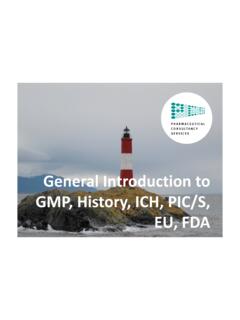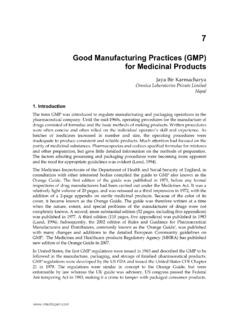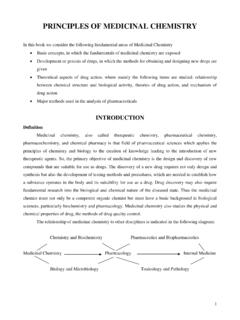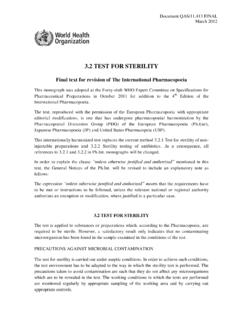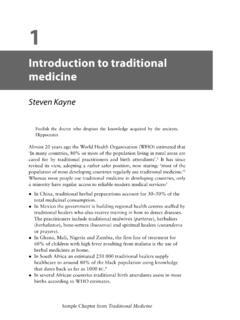Transcription of Ethiopian Herbal Medicine Research Profile
1 September, 2017 Traditional and Modern Medicine Research Directorate Addis Ababa, Ethiopia Compiled and Edited by: Ashenif Tadele Ethiopian Herbal Medicine Research Article Profile Part 1 Ethiopian Herbal Medicine Research Profile Ethiopian Public health Institute Page 2 Contents INTRODUCTION .. 3 Rationale for Development of Herbal Remedies .. 5 Up to 1990 .. 6 1991 .. 12 1992 .. 14 1993 .. 15 1994 .. 18 1995 .. 20 1996 .. 21 1998 .. 23 1999 .. 25 2000 .. 31 2001 .. 34 2002 .. 43 2003 .. 52 2004 .. 63 2005 .. 67 2006 .. 85 2007 .. 98 2008 .. 116 2009 .. 126 2010 .. 141 2011 .. 160 2012 .. 178 2013 .. 194 2014 .. 240 2015 .. 294 Annex I Researched Medicinal Plants .. 335 Ethiopian Herbal Medicine Research Profile Ethiopian Public health Institute Page 3 INTRODUCTION Plants have been used as medicinal sources since ancient times, and even today, plant based pharmacopoeias continue to play an essential role in world health care.
2 The use of biological resources for various therapies has been documented in many different parts of the world , especially in remote regions where traditional medicines provide an alternative to "modern" health care system this perhaps may be sequel to the inability of orthodox Medicine to comprehensively address most disease conditions plaguing mankind. The world health organization estimated that 80% of the world population relies on traditional Medicine prepared mainly by the use of natural products (animals and plants) to meet their daily health requirements. WHO estimates that of the 35, 000 70,000 species of plants that are used for medicinal purposes around the world , medicinal plants also play a major role and constitute the backbone of TM (Traditional System of Medicine ) practices. Hence, developing countries should endeavour to develop and utilize local medications that are most appropriate to their local circumstances especially for Primary health Care (PHC) in order to cut down on huge cost associated with incessant drug importation.
3 Ethiopia is a centre of diversity for a number flora and fauna the sixth centers of biodiversity in the world . The country is endowed with rich flora, having more than 6,500 species of vascular plants out of which an estimated 12% are endemic and about 887 species are used as medicinal plants. The majority (80%) of Ethiopian people depends on traditional Medicine for their health care, and more than 95% of traditional medicinal preparations made from plant origin. Ethiopia is also a home for many languages, cultures and beliefs that have in turn contributed to the high diversity of traditional knowledge and practice of the people, which, among others include the use of medicinal plants. Herbal Medicine in the simplest form are medicines or drugs made from herbs or plants and can be said to process several synonyms all of which refer to plants as the raw materials for Medicine namely, phytomedicines, plant medicines, green medicines, traditional Medicine portions, traditional remedies plant drugs and forest health products among others [6].
4 The world health organization also defined Herbal Medicine as finished labeled medicinal products that contain as active ingredients aerial or underground parts of plants or other plant materials or combinations thereof whether in crude juices, gums and fatty oils and other substances of this nature. Herbal Ethiopian Herbal Medicine Research Profile Ethiopian Public health Institute Page 4 Medicine may contain standard excipients in addition to the active ingredients. Medicines containing plant material combined with chemically defined active substances including chemically defined isolated constituents of plants are not considered to be Herbal Medicine . Exceptionally, in some countries Herbal Medicine may also contain by tradition, natural organic or inorganic active ingredients which are not or plant origin. Through technological Research and Development, countries of the Far East Asia such as China, South Korea and India have been able to have been able to meet 75% of their health care needs through the development and utilization of Herbal Medicine and traditional Medicine practice.
5 China for instance is the world leading producer and exporter of Herbal Medicine . The annual industrial output for China In 1993 amounted to $ billion and reached to $ billion in 2010, up from the previous year with a total profit of nearly $ billion in 2010. Complementary/alternative Medicine sales in Australia totaled US$ billion in In Japan, Herbal Medicine sales reached to US$ billion in 2008, in republic of Korea where annual expenditures on traditional Medicine were US$ billion in 2004, rising to US$ billion in 2009. The main aim of this document is to show the Research Profile of Ethiopian traditional medicines up to 2015 from published scientific studies in Ethiopia . Ethiopian Herbal Medicine Research Profile Ethiopian Public health Institute Page 5 Rationale for Development of Herbal Remedies Over the past 100 years, the development and mass production of chemically synthesized drugs have revolutionized health care in most parts of the word.
6 However, large sections of the population in developing countries still rely on traditional practitioners and Herbal medicines for their primary care. In Africa up to 90% and in Ethiopia 80% of the population depend on traditional Medicine to help meet their health care needs. Herbal Medicine has been commonly used over the years for treatment and prevention of diseases and health promotion as well as for enhancement of the span and quality of life. Plants and natural sources form the basis of today s modern Medicine and contribute largely to the commercial drug preparations manufactured today, about 25% of drugs prescribed worldwide are derived from plants such as atropine, morphine, quinine, ephedrine, warfarin, aspirin, digoxin, vincristine, taxol, and hyoscine. However, there is a lack of a systematic approach to assess their quality, safety and effectiveness. The holistic approach to health care makes Herbal Medicine very attractive to many people, but it also makes scientific evaluation very challenging because so many factors must be taken into account.
7 Herbal medicines are in widespread use and although many believe Herbal medicines are safe, they are often used in combination and are drawn from plant sources with their own variability in species, growing conditions, and biologically active constituents. Herbal extracts may be contaminated, adulterated, and may contain toxic compounds. The quality control of Herbal medicines has a direct impact on their safety and efficacy. But, there is little data on the composition and quality of most Herbal medicines, lack of adequate or accepted Research methodology for evaluating traditional Medicine . Research is needed for screen out bioactive compounds, assuring the quality, safety, molecular effects, and clinical efficacy and development new products of the numerous herbs in common usage, providing training on traditional Medicine and providing information and education of the community for improving their health care.
8 Ethiopian Herbal Medicine Research Profile Ethiopian Public health Institute Page 6 Up to 1990 1. Pankhurst R. The history and traditional treatment of smallpox in Ethiopia. Med Hist 1965;9:343-346. 2. Pankhurst R. An historical examination of traditional Ethiopian Medicine and surgery. Eth Med J. 1965;3(4):157-72. 3. Pankhurst R (1965) The history and traditional treatment of rabies in Ethiopia. Med Hist 9: 343-355. 4. Pankrust R: Historical reflections on the Traditional Ethiopian Pharmacopoeia. J Ethiop Pharm Assoc 1976, 2:29-33 5. Berhane-Selassie, T. 1971. An Ethiopian Medical Text Book written by Gerazmach Gabrawald Aragahan, Daga Damot. Addis Abeba University, Institute of Ethiopian Studies. Addis Abeba. 6. Abate, G. B., T. Gebre Egziabher & M. Tadesse. 1976. A study on the medicinal plants of Ethiopia, Unpublished. Science Faculty, Addis Abeba University.
9 7. Kloos, H. 1976. Preliminary studies of medicinal plants and plant products in markets of central Ethiopia. Ethnomedicine 4:63-102. 8. Tewolde-Berhan Gebre-Egziabher, Gelahun Abate and Mesfin Tadesse, 1976. A Study of theMedicinal Plants of Ethiopia, Part 1. Department of Biology, Addis Ababa University (mimeographed, in Amharic). 9. Kloos, H., A. Tekle, L. Yohannes, A. Yosef & A. Lemma. 1978. Preliminary studies of traditional medicinal plants in nineteen markets in Ethiopia: use patterns and public health aspects. Ethiopian Medical Journal 16:33-43. 10. Abegaz, B. and Dagne, E. (1978), Comparative bioassay studies of some traditional anlhelmintic plants, plant extracts and modern drugs. SINET: 1(2): 117- 121. 11. Tsega, E., Landells, J., Teklehaimanot, R., Berkassa, T., Tessema, D. (1978), Kosso toxicity in mice. SINET: 1(2): 99-106 12. Slikkerveer health development in Ethiopia.
10 Problems of utilization of traditional Sci Med 1982;16(21):1859-72. Abstract Ethiopian Herbal Medicine Research Profile Ethiopian Public health Institute Page 7 In Ethiopia, a pluralistic complex of multiple and simultaneous medical care utilization has constituted the Ethiopian variant of medical pluralism in East Africa, where through a process of acculturation, Cushitic, Arabic and Amharic medical traditions co-exist with cosmopolitan Medicine . On request of the central government, joint medical-sociological and anthropological Research between in Universities of Addis Ababa and Leiden was conducted in the Eastern Highlands with the main objective to formulate recommendations for the improvement and extension of the health care facilities in the rural areas. The situational analysis revealed relatively low utilization rates of the "official' health services by the local population.

